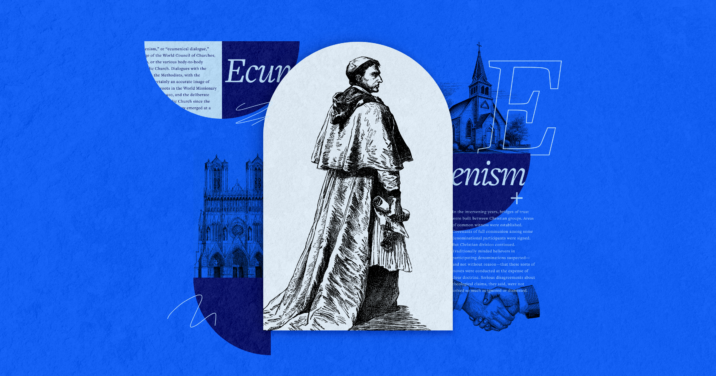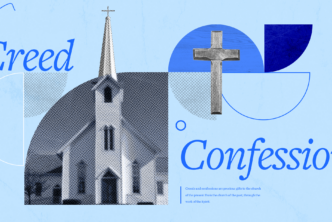Another Week of Prayer for Christian Unity has passed, and a recent picture of current Archbishop of Canterbury, Justin Welby, blessing Pope Francis has, at least in some quarters, generated controversy.
Recent convert to Catholicism and former Anglican priest (and Chaplain to Queen Elizabeth II), Gavin Ashenden, for example, provocatively called the depiction, “the triumph of cosmetic presentation over reality—to be more topical, a sort of ecclesiastical drag show.”1 His point, as the title of his article clarifies, is that such actions are entirely about performance, with nothing at all of substance behind them. No new agreement on any number of points of disagreement had been reached—indeed the inclusion of female Anglican bishops in his Rome delegation placed permanent disagreement squarely in the forefront. Matters of substance had been entirely displaced by what Ashenden calls “the nice.” The performance is the point.
Still, on Thursday, January 25, thousands of Christians worldwide joined across our divisions and gathered to pray for the realization of our Lord’s prayer for unity (John 17:21). I was one of them; indeed, I was the guest preacher at a joint service sponsored by local Catholic and Lutheran parishes.
You might think, then, that I will take umbrage with Ashenden and those like him who continue to insist that when it comes to official ecumenical dialogues, the emperor has no clothes. This would be a mistake.
However bracing or even harsh pieces like Ashenden’s can be, they tell the truth: visible unity is, if anything, even further away than when the various dialogues among and between various Christian communities began officially a century ago. So much of what is called ecumenism seems interested not so much in ending divisions as in normalizing them:2 despite our serious divisions, we will perform/pretend unity for the sake of good feelings, good manners, good press.
This post explains why I, an Anglican priest serving in a Lutheran parish, an active participant in formal and informal ecumenical conversations with Catholics (Roman, Ordinariate, and Eastern), think ecumenical dialogue in its current form has met its end—that is, its goal—and what this might portend for the future.
Institutional ecumenism
When we hear the words “ecumenism,” or “ecumenical dialogue,” many Christians conjure an image of the World Council of Churches, the World Evangelical Fellowship, or the various body-to-body dialogues conducted by the Catholic Church. Dialogues with the Lutherans, with the Reformed, with the Methodists, with the Pentecostals, and so on.
And this is certainly an accurate image of ecumenism. These dialogues have their roots in the World Missionary Conference that took place in Edinburgh in 1910, and the deliberate ecumenical outreach undertaken by the Catholic Church since the Second Vatican Council.
On the Protestant side, they emerged at a time of large-scale optimism. As the documents from Edinburgh 1910 make plain, its participants were convinced that they were on the cusp of the greatest missionary expansion of Christian faith ever. Doctrinal and denominational distinctives were about to be subordinated to that missionary cause.
Two world wars chastened that optimism but did not dampen the perceived need to remove as many obstacles to institutional unity as possible. In fact, the wars increased the perceived need.
When the World Council of Churches was formally organized in 1948, Christian Europe was devastated, the Cold War had just begun, and the threat of nuclear weapons was keenly felt. Many churches bore an acute sense of responsibility in their failure to prevent global bloodshed. All the more reason to remove as many barriers as possible to provide a united gospel witness in a world very different than that dreamed of by the postmillennial optimists of Edinburgh.
In the intervening years, bridges of trust were built between Christian groups. Areas of common witness were established. Covenants of full communion among some denominational participants were signed. But Christian division continued.
Traditionally minded believers in participating denominations suspected—and not without reason—that these sorts of moves were conducted at the expense of clear doctrine. Serious disagreements about theological claims, they said, were not solved so much as ignored or dismissed.
As the decades passed, the WCC seemed to its critics to pursue a strategy of baptizing bland center-left political positions that had been adopted prior to biblical or theological engagement. Instead of the robust common witness envisaged by its early founders (John R. Mott and Willem Visser ‘t Hooft, for example), we ended up with entirely predictable press releases that consistently annoyed traditionalists even as they were trumpeted by progressives.
Perhaps the defining moment of Institutional Ecumenism came in 1999, with the publication of The Joint Declaration on Justification by the Lutheran World Federation and the Catholic Church. Although it did not declare the Reformation over, this statement concluded that whatever disagreements remained over the matter of justification by faith, these were no longer to be conceived of as church-dividing.
Since 1999, the World Methodist Council, the Anglican Consultative Council, and the World Communion of Reformed Churches have all signed on to the Joint Declaration.
On the one hand, the document truly is remarkable, helping its signatories move past misunderstandings and thereby putting an end to overheated Reformation rhetoric inherited by both sides. On the other, however, ecclesially, nothing changed. Justification simply is not the article by which the church stands or falls anymore. Since the dawn of the Reformation, any number of dividers have been added. The most painful ones today are anthropological.
In 1999, everything should have changed; nothing did. Lamentably, we carry on as though division is normal and not at all a scandal.
Doctrinal ecumenism
Even as Institutional Ecumenism was showing signs of theological exhaustion and opting increasingly for performance over substance, small groups of people began to gather across confessional lines to talk about doctrine.
Two observations about “doctrinal ecumenism” must immediately be made.
First, it was in just about every way different from the Institutional Ecumenism that had been well in place for almost a century. It was not dialogue between institutions, but between individuals. Accordingly, whatever agreements were signed carried only the weight of the signatories.
Second, it was comprised of people oddly grouped together: people on all sides whose pieties were more traditionalist, and whose concern for doctrinal precision was accordingly more pronounced.
Unlike the ecumenism pursued by their more liberal brethren, unity, for this new group, was not going to be about the removal of political barriers, as much as it would be about coming together around the truth.
And if agreement in truth could not be attained, then clarity about what divided would be sought. Common moral and social commitments, especially around “life issues,” was another point of contact. This would be what Timothy George called an “ecumenism of the trenches” rather than of the university classroom or conference hall.
Most importantly, though, these conversations began not with doctrine, but with the establishment of personal friendships. We might think here of the friendship between Charles Colson and Fr. Richard John Neuhaus, or between Billy Graham and Pope John Paul II.
Why is the establishment of cross-confessional friendships so important? As a result of these friendships, people across doctrinal divisions began to recognize a common Christian faith that persisted. A shared faith that did not diminish or dismiss division but demanded that even the most painful points of rupture be looked at squarely, with good will, to see what resolutions, if any, could be accomplished. My own work—on Mary, Pope John Paul II, and Pope Benedict XVI—is rooted, at least vicariously, in these friendships. Billy Graham’s friendship with Pope John Paul II coupled with my own interest in life issues opened a door to Catholic friends.
Will this movement succeed in visible unity where the larger, institutional actions have ended in stalemate? Both sides commonly insist that the doctrinal unity for which they strive and hope will be attained only as the result of a miracle, that it may now even be an eschatological hope. And yet, the answer is not necessarily no. Ecumenical success is, I believe, possible—provided we are clear on just what success looks like.
Jail cell ecumenism
This more ad hoc, lower-profile ecumenism will not end up in a kind of pantomime that seeks to normalize Christian division precisely—because it is rooted in friendship and trust and is taking place in a growing context of marginalization and even persecution.
If, as I strongly suspect, George’s metaphorical “ecumenism of the trenches” will, perhaps in the lifetime of my children, if not my own, become a literal “ecumenism of the jail cell,” then perhaps, in God’s Providence, we will recognize brothers not by common confession (at least not beyond “Jesus, not Caesar, is Lord,”) but by a common willingness to suffer for the sake of the Name (Acts 5:41). We might here recall the words of the late Francis Cardinal George:
I expect to die in bed, my successor will die in prison and his successor will die a martyr in the public square. His successor will pick up the shards of a ruined society and slowly help rebuild civilization, as the church has done so often in human history.3
Cardinal George did indeed die in his bed. His successor has not (and likely will not) die in prison. But his point is true, if made dramatically.
Traditionally minded Christians are being pushed to the margins. And not just by the forces of secularism, but often by fellow Christians. And it may well be that God has prepared us for times such as these (Esth 4:14) by allowing us to build strong friendships that admit to what Archbishop Emeritus Chaput has called “fraternal disagreement,” acknowledging the reality of the doctrinal division that separates us, and recognizing a common witness to the one Lord Jesus in spite of it.
This ecumenism is, I believe, a gift of God to prepare us for the “church of tomorrow,” that will have lost its “social privileges.” “The Church will be a more spiritual Church, not presuming upon a political mandate, flirting as little with the Left as with the Right.” Her crisis “will make her poor and cause her to become the church of the meek. The process will be all the more arduous for sectarian narrow-mindedness as well as pompous self-will will have to be shed.” This church is and will be one “facing very hard times. The real crisis has scarcely begun. We will have to count on terrific upheavals.” What will remain in the end? Not “the church of the political cult, which is dead already … but the Church of faith. She may well be no longer the dominant social power . … But she will enjoy a fresh blossoming and be seen as man’s home, where he will find life and hope beyond death.”4
First penned fifty-five years ago, these words of a then-future-pope strike me today as prophecy-being-fulfilled. What Ratzinger predicted in the days when many were once again recovering a pre-War optimism for Christianity seemed awfully out-of-step with the times.
Now, however, it is perfectly obvious. We are experiencing the winnowing he described. Old certainties, social conventions, and expectations are gone in Europe and Canada and, despite late-evangelicalism’s dalliances with politics of the Left and Right, are failing in the USA also. Our “treaties with the Egyptians” (Isa 30–31; 2 Kgs 18–19) will not save us from our own approaching Assyria. Only a divine deliverance will.
In this changed social circumstance, Christians are going to need friends. We are going to need, dare I say, brothers and sisters who recognize why we disagree, why those disagreements cannot be waved away, and the reality that the Lord who has claimed us all is greater than these.
Books by Tim Perry
After Dispensationalism: Reading the Bible for the End of the World
Regular price: $26.99
Related articles
- The Definitive Guide to Christian Denominations
- Unity without Compromise: Councils & Creeds for Today’s Ecumenical Dialogue
- Everyone Can Study Church History: Here’s How
- Gavin Ashenden, “The meaningless vacuity of just being ‘nice’,” The Catholic Herald, January 28, 2024.
- See Peter J. Leithart, The End of Protestantism: Pursuing Unity in a Fragmented Church (Grand Rapids, IL: Brazos, 2016).
- As reported in Tim Drake, “Cardinal George: The Myth and Reality of I’ll die in my Bed,” National Catholic Register.
- Joseph Ratzinger, “What will the Church Look Like?,” in Faith and the Future (San Francisco: Ignatius, 2009), 116–18.





